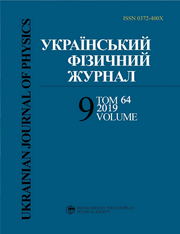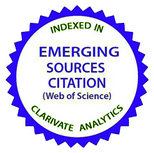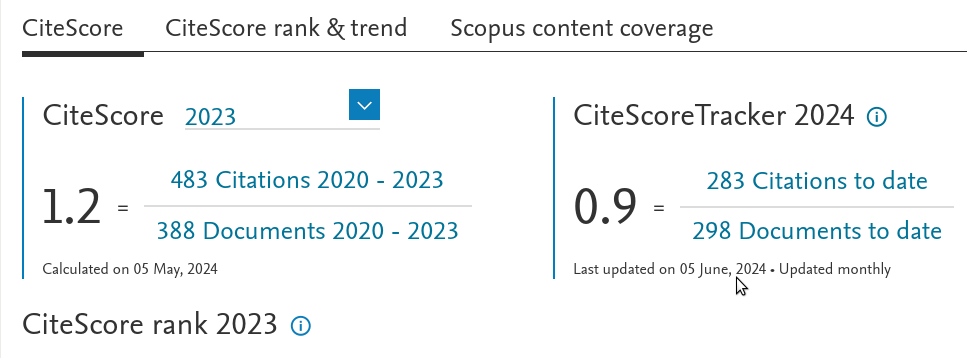Пулова модель екзоцитозу медіатору в синапс
DOI:
https://doi.org/10.15407/ujpe64.9.829Ключові слова:
нейрон, синапс, медiатор, пресинаптична мембранаАнотація
Пропонується модель, яка описує вивiльнення медiатору в синаптичну щiлину i враховує пулову структуру пресинаптичної областi. Припускається, що пресинаптична область мiстить два пули з везикулами, якi акумулюють медiатор. Пiд час надходження нервового iмпульсу з першого пулу в синаптичну щiлину видiляється медiатор. При цьому з другого пулу медiатор дифундує в перший пул. Поповнення другого пулу вiдбувається за рахунок поглинання медiатору iз синаптичної щiлини. Всi цi процеси враховуються в запропонованiй моделi. Також ми розглядаємо рiзнi режими функцiонування системи. Зокрема, дослiджено особливостi передачi системою окремого iмпульсу, а також проаналiзовано ситуацiю, коли в системi має мiсце зворотний зв’язок (вихiдний сигнал подається на вхiд системи). Показано, що в такому режимi iснує граничне значення для параметра, котрий визначає iнтенсивнiсть зворотного зв’язку. Якщо значення даного параметра не перевищує граничне, наявнiсть зворотного зв’язку якiсно не впливає на функцiонування системи.
Посилання
R.W. Holz, S.K.Fisher. Synaptic transmission and cellular signaling: An overview. In Basic Neurochemistry (Elsevier, 2012), p. 235. https://doi.org/10.1016/B978-0-12-374947-5.00012-2
T.C. S¨udhof, R.C.Malenka. Understanding synapses: past, present, and future. Neuron 60, 3, 469 (2008). https://doi.org/10.1016/j.neuron.2008.10.011
H.W. Davenport. Early history of the concept of chemical transmission of the nerve impulse. Physiologist 34, No. 4, 129 (1991).
T.C. S¨udhof. The synaptic vesicle cycle. Annu. Rev. Neurosci. 27, 509 (2004). https://doi.org/10.1146/annurev.neuro.26.041002.131412
R. Jahn. Principles of exocytosis and membrane fusion. Ann. New York Acad. Sci. 1014, 170 (2004). https://doi.org/10.1196/annals.1294.018
U. Becherer, J. Rettig. Vesicle pools, docking, priming and release. Cell Tiss. Res. 326, 393 (2006). https://doi.org/10.1007/s00441-006-0243-z
D. Bonanomi, F. Benfenati, F. Valtorta. Protein sorting in the synaptic vesicle life cycle. Prog. Neurobiol. 80, 177 (2006). https://doi.org/10.1016/j.pneurobio.2006.09.002
V.A. Klyachko, M.B. Jackson. Capacitance steps and fusion pores of small and large-dense-core vesicles in nerve terminals. Nature 418, 89 (2002). https://doi.org/10.1038/nature00852
J.Y. Sun, X.S. Wu, L.G. Wu. Single and multiple vesicle fusion induce different rates of endocytosis at a central synapse. Nature 417, 555 (2002). https://doi.org/10.1038/417555a
C. Paillart, J. Li, G. Matthews, P. Sterling. Endocytosis and vesicle recycling at a ribbon synapse. J. Neurosci. 23, 4092 (2003). https://doi.org/10.1523/JNEUROSCI.23-10-04092.2003
T. Fernandez-Alfonso, T.A. Ryan. The kinetics of synaptic vesicle pool depletion at CNS synaptic terminals. Neuron 41, 943 (2004). https://doi.org/10.1016/S0896-6273(04)00113-8
D. Lenzi, J. Crum, M.H. Ellisman, W.M. Roberts. Depolarization redistributes synaptic membrane and creates a gradient of vesicles on the synaptic body at a ribbon synapse. Neuron 36, 649 (2002). https://doi.org/10.1016/S0896-6273(02)01025-5
D. Zenisek, J.A. Steyer, M.E. Feldman, W. Almers. A membrane marker leaves synaptic vesicles in milliseconds after exocytosis in retinal bipolar cells. Neuron 35, 1085 (2002). https://doi.org/10.1016/S0896-6273(02)00896-6
E. Hanse, B. Gustafsson. Paired-pulse plasticity at the single release site level: An experimental and computational study. J. Neurosci. 21, 8362 (2001). https://doi.org/10.1523/JNEUROSCI.21-21-08362.2001
E. Hanse, B. Gustafsson. Release dependence to a paired stimulus at a synaptic release site with a small variable pool of immediately releasable vesicles. J. Neurosci. 22, 4381 (2002). https://doi.org/10.1523/JNEUROSCI.22-11-04381.2002
J. Trommershauser, R. Schneggenburger, A. Zippelius, E. Neher. Heterogeneous presynaptic release probabilities: Functional relevance for short-term plasticity. Biophys. J. 84, 1563 (2003). https://doi.org/10.1016/S0006-3495(03)74967-4
J.Y. Sun, L.G. Wu. Fast kinetics of exocytosis revealed by simultaneous measurements of presynaptic capacitance and postsynaptic currents at a central synapse. Neuron 30, 171 (2001). https://doi.org/10.1016/S0896-6273(01)00271-9
A. Llobet, V. Beaumont, L. Lagnado. Real-time measurement of exocytosis and endocytosis using interference of light. Neuron 40, 1075 (2003). https://doi.org/10.1016/S0896-6273(03)00765-7
A.V. Chalyi, L.M. Chernenko. Phase transition in finite-size systems and synaptic transmission. In Dynamical Phenomena at Interfaces, Surfaces and Membranes (Nova Science, 1993). p. 457.
A.V. Chalyi, A.N. Vasilev, E.V. Zaitseva. Synaptic transmission as a cooperative phenomenon in confined systems. Cond. Matter Phys. 20, 13804 (2017). https://doi.org/10.5488/CMP.20.13804
A.N. Vasilev, A.V. Kulish. The influence of mediator diffusion on the trigger mode of synapse functioning. Biofizika 59, 373 (2014) (in Russian). https://doi.org/10.1134/S0006350914020262
S.I. Braichenko, O.M. Vasilev. Modeling of postsynaptic membrane activation. Zh. Fiz. Dosl. 16, 4802 (2012) (in Ukrainian).
A.N. Vasilev, O.V. Kulish. Model of postsynaptic membrane deactivation. Ukr. J. Phys. 63, 919 (2018). https://doi.org/10.15407/ujpe63.10.919
O.V. Kulish, A.N. Vasilev. Modeling the nerve impulse transmission in a synaprtic cleft. J. Phys. Stud. 23, 1801 (2019). https://doi.org/10.30970/jps.23.1801
S.O. Rizzoli, W.J. Betz. Synaptic vesicle pools. Nature Rev. Neurosci. 6, 57 (2005). https://doi.org/10.1038/nrn1583
S.O. Rizzoli, W.J. Betz. The structural organization of the readily releasable pool of synaptic vesicles. Science 303, 2037 (2004). https://doi.org/10.1126/science.1094682
R. Schneggenburger, T. Sakaba, E. Neher. Vesicle pools and short-term synaptic depression: Lessons from a large synapse. Trends Neurosci. 25, 206 (2002). https://doi.org/10.1016/S0166-2236(02)02139-2
A.V. Chalyi, E.V. Zaitseva. Strange attractor in kinetic model of synaptic transmission. J. Phys. Stud. 11, 322 (2007).
O.V. Chalyi, O.V. Zaitseva. A kinetic model of synaptic transmission on intercell interaction. Ukr. J. Phys. 54, 366 (2009).
O.M. Vasilev, S.V. Kislyak. Two-pool kinetic model of synapse activation. Zh. Fiz. Dosl. 14, 4801 (2010) (in Ukrainian).
A.N. Vasilev, S.V. Kislyak. Model of mediator exocytosis into the synapse. Fiz. Zhiv. 18, No. 2, 47 (2010).
C.M. Anderson, R.A. Swanson. Astrocyte glutamate transport: review of properties, regulation, and physiological functions. Glia 32, 1 (2000). https://doi.org/10.1002/1098-1136(200010)32:1<1::AID-GLIA10>3.0.CO;2-W
A.K. Vidybida. Output stream of binding neuron with instantaneous feedback. Eur. Phys. J. B 65, 577 (2008). https://doi.org/10.1140/epjb/e2008-00360-1
A.K. Vidybida, K.G. Kravchuk. Output stream of binding neuron with delayed feedback. Eur. Phys. J. B 72, 279 (2009). https://doi.org/10.1140/epjb/e2009-00309-x
A.K. Vidybida. Activity of excitatory neuron with delayed feedback stimulated with Poisson stream is non-Markov. J. Stat. Phys. 160, 1507 (2015). https://doi.org/10.1007/s10955-015-1301-2
A.K. Vidybida. Fast Cl-type inhibitory neuron with delayed feedback has non-Markov output statistics. J. Phys. Stud. 22, 4801 (2018). https://doi.org/10.30970/jps.22.4801
##submission.downloads##
Опубліковано
Як цитувати
Номер
Розділ
Ліцензія
Ліцензійний Договір
на використання Твору
м. Київ, Україна
Відповідальний автор та співавтори (надалі іменовані як Автор(и)) статті, яку він (вони) подають до Українського фізичного журналу, (надалі іменована як Твір) з одного боку та Інститут теоретичної фізики імені М.М. Боголюбова НАН України в особі директора (надалі – Видавець) з іншого боку уклали даний Договір про таке:
1. Предмет договору.
Автор(и) надає(ють) Видавцю безоплатно невиключні права на використання Твору (наукового, технічного або іншого характеру) на умовах, визначених цим Договором.
2. Способи використання Твору.
2.1. Автор(и) надає(ють) Видавцю право на використання Твору таким чином:
2.1.1. Використовувати Твір шляхом його видання в Українському фізичному журналі (далі – Видання) мовою оригіналу та в перекладі на англійську (погоджений Автором(ами) і Видавцем примірник Твору, прийнятого до друку, є невід’ємною частиною Ліцензійного договору).
2.1.2. Переробляти, адаптувати або іншим чином змінювати Твір за погодженням з Автором(ами).
2.1.3. Перекладати Твір у випадку, коли Твір викладений іншою мовою, ніж мова, якою передбачена публікація у Виданні.
2.2. Якщо Автор(и) виявить(лять) бажання використовувати Твір в інший спосіб, як то публікувати перекладену версію Твору (окрім випадку, зазначеного в п. 2.1.3 цього Договору); розміщувати повністю або частково в мережі Інтернет; публікувати Твір в інших, у тому числі іноземних, виданнях; включати Твір як складову частину інших збірників, антологій, енциклопедій тощо, то Автор(и) мають отримати на це письмовий дозвіл від Видавця.
3. Територія використання.
Автор(и) надає(ють) Видавцю право на використання Твору способами, зазначеними у п.п. 2.1.1–2.1.3 цього Договору, на території України, а також право на розповсюдження Твору як невід’ємної складової частини Видання на території України та інших країн шляхом передплати, продажу та безоплатної передачі третій стороні.
4. Строк, на який надаються права.
4.1. Договір є чинним з дати підписання та діє протягом усього часу функціонування Видання.
5. Застереження.
5.1. Автор(и) заявляє(ють), що:
– він/вона є автором (співавтором) Твору;
– авторські права на даний Твір не передані іншій стороні;
– даний Твір не був раніше опублікований і не буде опублікований у будь-якому іншому виданні до публікації його Видавцем (див. також п. 2.2);
– Автор(и) не порушив(ли) права інтелектуальної власності інших осіб. Якщо у Творі наведені матеріали інших осіб за виключенням випадків цитування в обсязі, виправданому науковим, інформаційним або критичним характером Твору, використання таких матеріалів здійснене Автором(ами) з дотриманням норм міжнародного законодавства і законодавства України.
6. Реквізити і підписи сторін.
Видавець: Інститут теоретичної фізики імені М.М. Боголюбова НАН України.
Адреса: м. Київ, вул. Метрологічна 14-б.
Автор: Електронний підпис від імені та за погодження всіх співавторів.













